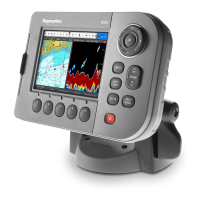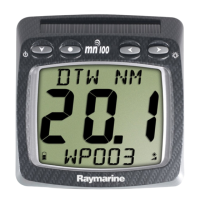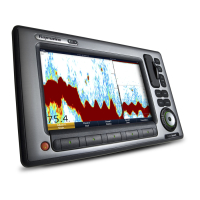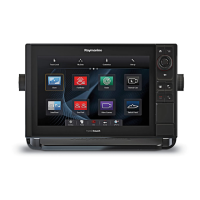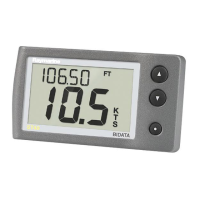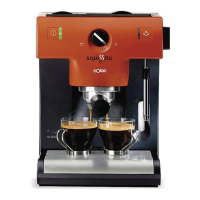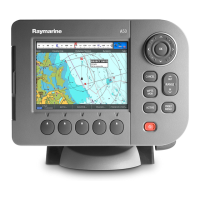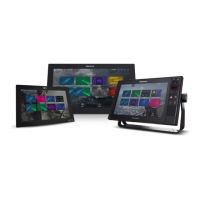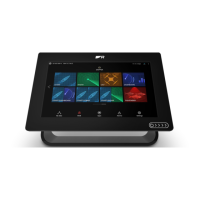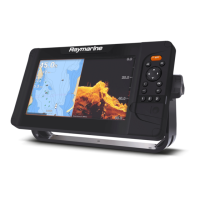Do you have a question about the Raymarine T210 and is the answer not in the manual?
Recommends use on boats up to 18m and advises on material construction.
States the system is an aid, skipper remains responsible for watch.
Warns against dismantling; battery replacement by trained personnel only.
Guides correct disposal of batteries and instruments per regulations.
Highlights solar power and wireless connectivity for easy setup.
Details functions for optimizing starts, performance, and navigation.
Explains automatic data selection and page hiding.
Describes high-contrast LCD and adjustable backlight colors.
Identifies key components on the Maxi Display screen.
Explains how to control and configure the display using a remote.
Instructions for switching the Micronet system on and off.
Describes how data is organized into chapters and pages for navigation.
Explains the solar power system and battery status indicators.
Details how to adjust display backlighting levels and colors.
Explains the automatic power-off feature for conserving energy.
Allows programming of display pages for different legs of a course.
Details the Depart, Race Timer, and Line Bias functions for starts.
Explains how to initialize and use the start line bias display.
Describes using the race timer, typically via a remote display.
Explains Trend and Acceleration indicators for speed and performance.
Details balancing pointing and speed to maximize VMG upwind.
Explains how to identify and utilize wind shifts for tactical advantage.
Advises on maximizing VMG downwind and timing gybes.
Explains Course Over Ground (COG) and Speed Over Ground (SOG) for tidal conditions.
Shows indicators for steering course to a waypoint.
Explains how the system calculates drift and set due to tide and leeway.
Details the structure of data presentation in chapters and pages.
Describes various audible alerts for system events and alarms.
Details specific alarms like Wind High, Cross Track Error, and Waypoint Arrival.
Explains how to customize the display by hiding unused pages.
Details basic operations using the single control button on the display.
Outlines the organization of setup chapters and pages.
Describes how to enter and navigate the setup and calibration modes.
Explains how to edit numeric, list, and toggle parameter values.
Details configuration options for the Autoleg feature in Simple and Advanced modes.
Defines angles for switching between Autoleg pages for different legs.
Explains how to clear trip memory and depth records.
Details how to reset maximum and average speed memories.
Configures trend and acceleration indicators for performance pages.
Adjusts speed readings to account for differences between tacks.
Configures boat length and GPS antenna position.
Sets preferred units for displaying start line distance.
Manages page hiding, backlight color, and control modes.
Configures mastership, demonstration mode, and factory reset.
Displays software versions, battery status, and signal strength.
Warns about safety and accuracy requirements for calibration.
Describes tests to check speed and compass calibration accuracy.
Refers to the remote display user guide for specific calibration tasks.
Provides guidance for mounting the display using a bracket.
Details how to mount the display directly onto a bulkhead.
Discusses surface preparation, screw usage, and component placement.
Provides instructions for cleaning and storing the display unit.
Addresses problems like system start-up, remote control, and calibration errors.
Explains alarms for power save, lost network, low battery, and data transmission issues.
Provides solutions for zero speed readings, missing NMEA data, depth alarms, and compass discrepancies.
Lists digit height, backlighting levels, and power source details.
Covers display units, alarm types, weight, temperature, and frequency.
Recommends use on boats up to 18m and advises on material construction.
States the system is an aid, skipper remains responsible for watch.
Warns against dismantling; battery replacement by trained personnel only.
Guides correct disposal of batteries and instruments per regulations.
Highlights solar power and wireless connectivity for easy setup.
Details functions for optimizing starts, performance, and navigation.
Explains automatic data selection and page hiding.
Describes high-contrast LCD and adjustable backlight colors.
Identifies key components on the Maxi Display screen.
Explains how to control and configure the display using a remote.
Instructions for switching the Micronet system on and off.
Describes how data is organized into chapters and pages for navigation.
Explains the solar power system and battery status indicators.
Details how to adjust display backlighting levels and colors.
Explains the automatic power-off feature for conserving energy.
Allows programming of display pages for different legs of a course.
Details the Depart, Race Timer, and Line Bias functions for starts.
Explains how to initialize and use the start line bias display.
Describes using the race timer, typically via a remote display.
Explains Trend and Acceleration indicators for speed and performance.
Details balancing pointing and speed to maximize VMG upwind.
Explains how to identify and utilize wind shifts for tactical advantage.
Advises on maximizing VMG downwind and timing gybes.
Explains Course Over Ground (COG) and Speed Over Ground (SOG) for tidal conditions.
Shows indicators for steering course to a waypoint.
Explains how the system calculates drift and set due to tide and leeway.
Details the structure of data presentation in chapters and pages.
Describes various audible alerts for system events and alarms.
Details specific alarms like Wind High, Cross Track Error, and Waypoint Arrival.
Explains how to customize the display by hiding unused pages.
Details basic operations using the single control button on the display.
Outlines the organization of setup chapters and pages.
Describes how to enter and navigate the setup and calibration modes.
Explains how to edit numeric, list, and toggle parameter values.
Details configuration options for the Autoleg feature in Simple and Advanced modes.
Defines angles for switching between Autoleg pages for different legs.
Explains how to clear trip memory and depth records.
Details how to reset maximum and average speed memories.
Configures trend and acceleration indicators for performance pages.
Adjusts speed readings to account for differences between tacks.
Configures boat length and GPS antenna position.
Sets preferred units for displaying start line distance.
Manages page hiding, backlight color, and control modes.
Configures mastership, demonstration mode, and factory reset.
Displays software versions, battery status, and signal strength.
Warns about safety and accuracy requirements for calibration.
Describes tests to check speed and compass calibration accuracy.
Refers to the remote display user guide for specific calibration tasks.
Provides guidance for mounting the display using a bracket.
Details how to mount the display directly onto a bulkhead.
Discusses surface preparation, screw usage, and component placement.
Provides instructions for cleaning and storing the display unit.
Addresses problems like system start-up, remote control, and calibration errors.
Explains alarms for power save, lost network, low battery, and data transmission issues.
Provides solutions for zero speed readings, missing NMEA data, depth alarms, and compass discrepancies.
Lists digit height, backlighting levels, and power source details.
Covers display units, alarm types, weight, temperature, and frequency.


